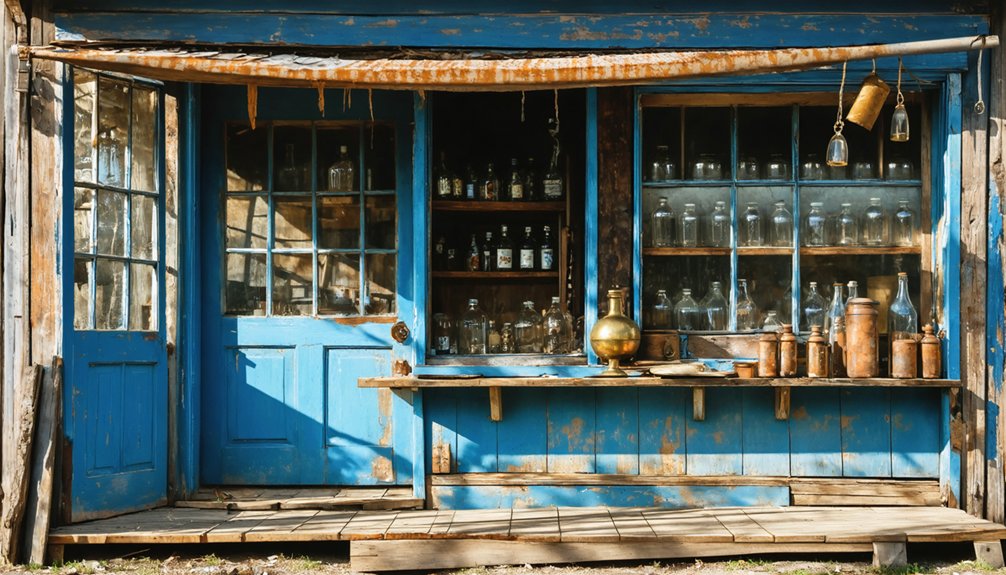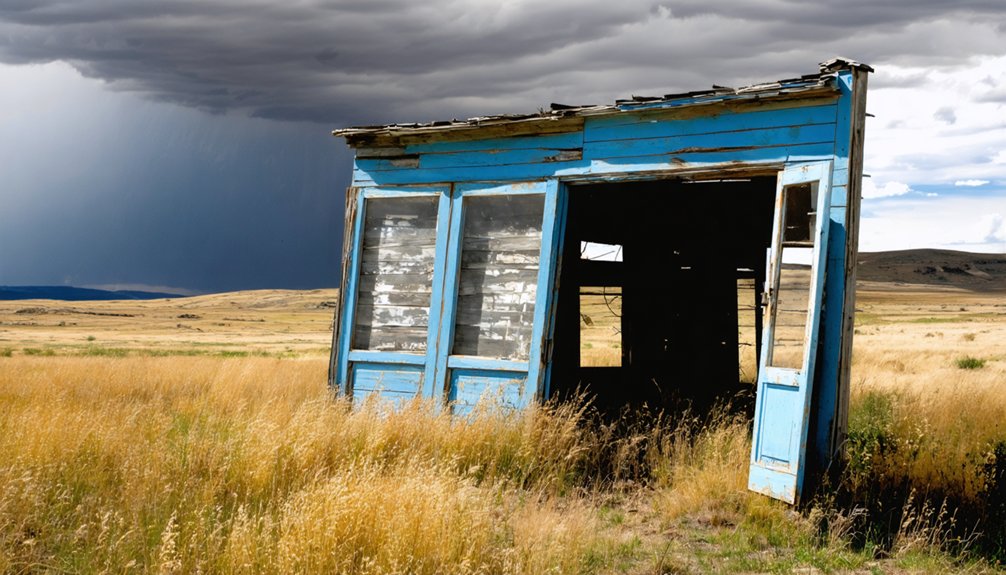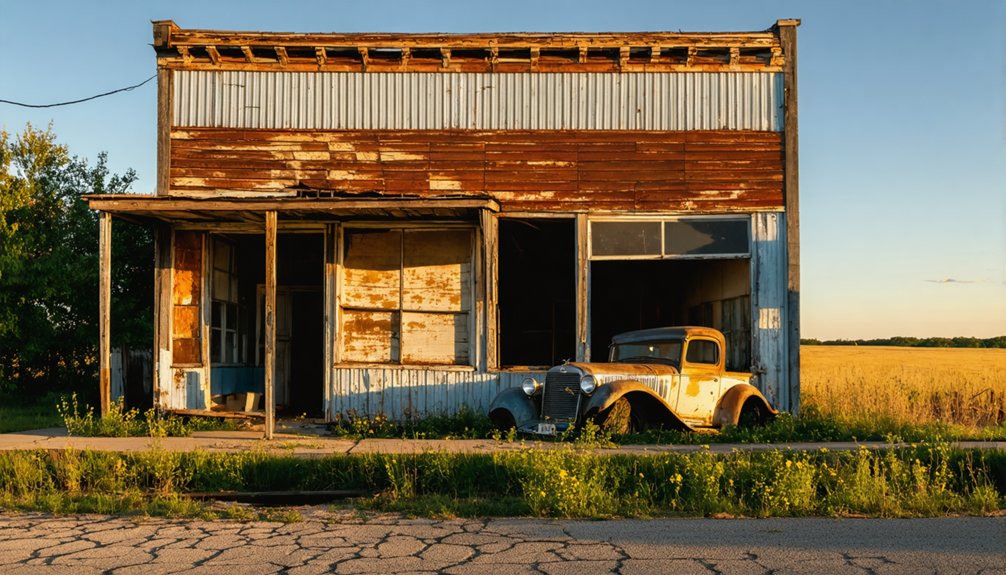You’ll discover Cascade’s haunting remnants in South Dakota’s Black Hills, where an 1888 Victorian resort town once thrived around natural mineral springs. The Gothic stone bank building still stands as the most prominent landmark, alongside ruins of the banker’s residence and bowling alley. While the town’s dreams of becoming a premier health destination ended when the railroad chose a different route, Cascade’s architectural legacy tells a fascinating story of ambition and decline that’s waiting to be explored.
Key Takeaways
- Cascade was founded in 1888 as a Victorian resort town centered around natural mineral springs with therapeutic properties.
- The town’s decline began when the railroad bypassed it, leading to its eventual abandonment despite once having 400 residents.
- The ornate sandstone bank building remains the most prominent landmark, showcasing the town’s Late Gothic architectural heritage.
- Natural warm springs still flow at 2,000 gallons per minute, maintaining 67-68°F temperature and creating a popular public swimming spot.
- Visitors can explore the remaining stone structures, including the bank and banker’s residence, though most buildings are now foundations.
The Birth of a Victorian Resort Town
While many Western towns emerged from mining or agriculture, Cascade, South Dakota began in 1888 as an ambitious Victorian resort destination centered around natural mineral springs.
You’ll find the town’s Victorian aspirations reflected in its late Gothic architecture, particularly in the ornate stone bank and banker’s residence that still stand today.
The founders envisioned a prosperous health tourism hub, positioning the town along what they believed would be the primary railroad route into the Black Hills. Like the Carlsbad of America, the town marketed itself as a premier health destination.
Betting on railroads and resorts, Cascade’s founders dreamed of transforming their mineral springs into the Black Hills’ premier health destination.
The warm springs, flowing at an impressive 2,000 gallons per minute, promised to attract wealthy visitors seeking therapeutic waters.
Yet despite these grand plans, Cascade’s resort aspirations crumbled when the railroad chose a different route, leading to one of the Black Hills’ most notable resort failures. Like many ghost town hunting sites, patient exploration is needed to discover its remaining structures.
Natural Springs and Tourist Dreams
You’d find the warm, mineral-rich waters of Cascade Springs enticing visitors seeking health cures in the late 1800s, when therapeutic bathing was all the rage.
Today, visitors can explore these historic waters at J.H. Keith Park, where scenic walking paths lead to the spring.
The constant 67-68 degree Fahrenheit springs inspired dreams of transforming this Black Hills hamlet into a premier Victorian health resort, complete with elaborate bathhouses and healing retreats.
The town quickly grew to include fifty thriving businesses and a population of 400 residents by the turn of the century, demonstrating its early promise as a destination.
While the grand resort plans never fully materialized, the springs’ enduring appeal drew generations of visitors to swim in the crystal-clear waters of what would become a cherished public swimming hole.
Natural Springs Health Benefits
Since time immemorial, the warm waters of Cascade Springs have offered remarkable therapeutic benefits that drew both indigenous peoples and early settlers to this unique Black Hills location.
You’ll discover the same thermal benefits that the Lakota and Cheyenne peoples cherished when they named it Minne-kahta, meaning “warm waters.” The springs’ consistent 67-68°F temperature creates perfect conditions for traditional hydrotherapy practices, improving circulation and easing muscle pain year-round. Today, visitors can experience these healing waters at the world’s largest pool, an indoor natural warm water facility built in 1890.
Unlike the region’s typically cold waters, these mineral-rich springs enhance skin health and support detoxification through natural immersion.
The sacred waters once served as a healing retreat, where visitors sought relief from various ailments including arthritis and respiratory conditions, establishing the area’s reputation as a natural wellness destination.
Victorian Resort Life Dreams
As ambitious Victorian entrepreneurs laid claim to Cascade’s warm springs in 1888, they envisioned a luxurious resort destination that would rival the grand spas of Europe. You would’ve found yourself immersed in Victorian leisure at its finest – a magnificent four-story hotel with 100 rooms, designed to welcome society’s elite seeking health tourism in the Black Hills.
The resort’s planners crafted thirty-six city blocks around the springs, which pumped out an impressive 2,000 gallons of warm mineral water per minute. You’d have experienced the era’s most fashionable health treatments while enjoying musical entertainment and social gatherings in ornate Gothic-style buildings. A rare wood carved souvenir discovered recently in a thrift store offers a tangible glimpse into this forgotten era. Most of these grand structures were eventually dismantled, and their stone materials were repurposed for construction in Hot Springs.
Though the dream was grand, the town’s fortunes tumbled when railroad routes bypassed Cascade, leaving only scattered remnants of this once-promising Victorian health retreat.
Architectural Grandeur of the Black Hills
As you explore Cascade’s architectural heritage, you’ll find a stunning blend of Victorian elegance and native Black Hills stonework in the remaining structures.
The town’s bank building, constructed with locally quarried stone, stands as a symbol of the region’s distinctive building traditions that emphasized durability and natural harmony. This design philosophy parallels the approach taken by architects who crafted lookout towers to blend seamlessly with their natural surroundings. The dark ponderosa pine forests that blanket the surrounding hills provided a dramatic backdrop for these architectural wonders.
This architectural legacy mirrors the broader Black Hills style, where Victorian-era craftsmanship merged seamlessly with indigenous materials to create enduring monuments to the area’s prosperous past.
Victorian Elegance Meets Nature
When Victorian settlers established Cascade in 1888, they brought an architectural grandeur that contrasted boldly with the rugged Black Hills landscape.
You’ll find evidence of this ambitious vision in the Gothic Revival banker’s home, where ornate stonework and pointed arches showcase the town’s aspirations for refinement amid the wilderness.
The town’s founders skillfully integrated Victorian aesthetics with the natural environment, particularly around the 68°F warm springs.
They built impressive stone structures that reflected both status and practicality, using locally quarried materials to create lasting landmarks.
These buildings weren’t meant to dominate the scenic surroundings but rather to complement them, creating an elegant escape where visitors could appreciate both architectural sophistication and the Black Hills’ raw beauty.
The emphasis on harmonizing with the landscape continued throughout the region’s development, as seen in later structures like the glue-laminated timber bridges that would define Black Hills architecture.
Bank’s Stone Legacy Endures
The majestic stone bank building stands as Cascade’s most enduring architectural achievement, its Gothic arches and intricate masonry work defying time and the elements.
You’ll find this representation of stone resilience among the Black Hills’ most significant early financial structures, where native sandstone and granite create an imposing presence that commanded respect in a frontier largely defined by wooden buildings.
The architectural symbolism speaks volumes about Cascade’s ambitious vision as a spa destination. Unlike the simple miner cabins dotting the landscape, this Victorian Gothic masterpiece, along with the banker’s equally impressive stone residence, showcases the town’s unrealized dreams of prosperity.
Today, you’ll discover these stone ruins serve as powerful monuments to the boom-and-bust cycle that shaped the Black Hills, attracting history enthusiasts and preservationists who recognize their enduring cultural value.
When the Railroad Passed By
During South Dakota’s peak railroad era of the 1910s, Cascade’s future dimmed as major rail lines bypassed the small settlement.
While railroad expansion transformed countless Dakota Territory towns into bustling centers of commerce, you won’t find Cascade among those success stories. The economic transformation that railways brought to the region – connecting farmers to eastern markets and enabling population booms – never reached this isolated community.
You can imagine the disappointment of Cascade’s residents as they watched neighboring towns flourish with new rail connections.
Without the lifeline of steel rails, Cascade couldn’t compete with rail-served communities that offered faster transport of goods and people. As highways and trucks eventually replaced trains, Cascade’s isolation only deepened, accelerating its decline into the ghost town you’ll find today.
Life in Cascade’s Golden Era

Founded in 1888, Cascade emerged as a promising spa destination built around its unique warm mineral springs, which maintained a constant temperature of 67 degrees Fahrenheit.
You’d find a thriving community where social gatherings centered around therapeutic bathing and leisure pursuits, with locals welcoming both regional and eastern tourists seeking rest from nearby mining activities.
The town’s community wealth manifested in its Victorian Gothic banker’s home, an ornate stone bank building, and a bowling alley where residents and visitors alike socialized.
The surrounding environment showcased nature’s splendor, with Cascade Falls‘ turquoise waters and rare flora creating an idyllic retreat.
Six artesian springs fed crystal-clear pools, fostering an ecosystem unique to South Dakota, where ferns, prairie gentian, and orchids flourished in the warm, mineral-rich waters.
The Ghost Town That Remains
Standing as a testimony to bygone prosperity, Cascade’s remaining structures tell a poignant story of architectural ambition and eventual decline.
You’ll find the ornate sandstone bank building, built from local Fall Creek stone, serving as the town’s most prominent ghost town history landmark. Nearby, a late Victorian Gothic banker’s home and bowling alley still stand, though many other buildings have succumbed to time and elements.
Nature has reclaimed much of what was once a bustling spa town, with foundations and scattered rubble the only remnants of most structures.
The architectural preservation of these few surviving buildings, especially the bank, captures Cascade’s brief moment of wealth and promise. While roofless and weathered, these silent sentinels overlooking the scenic valley remind you of the boom-and-bust cycle that shaped many Black Hills communities.
Planning Your Visit to Cascade

Planning a visit to Cascade requires careful timing and preparation to fully appreciate this historic Black Hills ghost town.
You’ll find the best experience by visiting during spring through fall, when the weather is favorable and you can explore the Victorian ruins and natural springs safely.
- Pack visitor essentials including water, snacks, and sturdy walking shoes – there aren’t any amenities in Cascade itself.
- Base your stay in nearby Hot Springs, where you’ll find modern accommodations and services for your travel preparations.
- Visit early in the day to maximize photography opportunities of the Gothic bank building and explore the rare plant species along designated paths.
Remember to respect this fragile landscape by staying on marked trails and treating historic structures with care during your exploration.
Frequently Asked Questions
Are There Any Paranormal Activities Reported in the Abandoned Buildings?
You won’t find documented ghost sightings or haunted locations here. Despite being an atmospheric abandoned town, there’s no credible evidence of paranormal activity in any of the remaining structures.
What Happened to the Original Hotel Furniture and Fixtures?
Like treasures lost to time, you’d find no surviving hotel furniture today. Without records of sales or preservation efforts, the fixtures were likely salvaged by locals or deteriorated after abandonment.
Did Any Famous People Ever Visit Cascade During Its Heyday?
You won’t find records of any famous visitors to Cascade during its prime – historical documents show it mainly attracted regional tourists seeking mineral springs rather than notable personalities of historical significance.
Can Visitors Still Access the Mineral Springs at the Site?
You can freely access the mineral springs through the Black Hills National Forest’s public day-use area. You’ll find maintained trails, picnic facilities, and swimming spots around the natural warm springs.
Were There Any Attempts to Revive the Town After Its Decline?
You’ll find limited revival efforts primarily focused on preserving the stone bank building, with some community interest from local artists and historians, but no major attempts to reestablish Cascade’s economy.
References
- https://www.sdpb.org/rural-life-and-history/2023-08-21/some-black-hills-ghost-towns-and-their-origins
- https://www.sdhspress.com/journal/south-dakota-history-2-2/some-black-hills-ghost-towns-and-their-origins/vol-02-no-2-some-black-hills-ghost-towns-and-their-origins.pdf
- https://watsonparkerphd.com/tag/cascade/
- https://watsonparkerphd.com/2021/01/21/cascade-sd/
- https://en.wikipedia.org/wiki/List_of_ghost_towns_in_South_Dakota
- https://www.ghosttowns.com/states/sd/cascadesprings.html
- https://www.sdpb.org/rural-life-and-history/History-of-the-Hot-Springs-bath-houses-and-holistic-health-retreats
- https://www.southdakotamagazine.com/whereizzit-nov-2013
- https://www.highlandmeadowsresort.com/post/evolution-of-hot-springs-sd
- https://www.southdakotamagazine.com/cascade-falls



